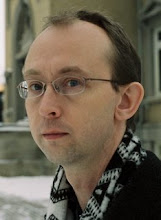
A scene from Whitmore Park (The Epic Story of My Life Part 4)
People often ask me if I get nervous before a screening at the Toronto International Film Festival, to which I reply, "ME? NERVOUS?!" and then I proceed to eat my own tongue.
I'm joking, it's really not the bad. In fact, by the time I premiere a film I've spent so much time sweating over every detail that part of me doesn't even care how it goes over, I'm just glad it's finished.
The most nerve wracking thing for me at a screening is the technical part. This is particularly a factor at a screening of several short films, because there could be many different screening formats in one program of films and this always increases the chances of something going wrong. At TIFF there's digi-beta tapes, HD Cam tapes, and 35mm film in two flavours: flat and 'scope. There's also different sound formats in 35mm as well. I decided to go Dolby Digital this year because that seems to be the most common audio format and therefore the most trouble-free. For anyone interested in the nuances of 35mm optical sound tracks, see my older post about that.
One of the things I like about making films is the ability to control all the possible details. I'm responsible for every frame of my short movie, it's like I 'approve' every single one of them. So my greatest fear is that one, or several of my precious frames will somehow not see the light of day. TIFF has an excellent projection record and a policy that the film will be started over if something terrible happens, but of course you want it to work right the first time so that everyone can just experience the film.
I find it amazing how something as simple as volume can make a big difference at a screening. One notch too low and the audience might be straining to hear. One notch too loud and they're uncomfortable, wondering if they should cover their ears or go tell someone to turn it down. As a filmmaker you can feel when it's not right and you can tell if the audience is uncomfortable. I've often thought someone should study audience response under different screening conditions just to see how much effect projection can have on the perception of any given film.
I think quality control is going to be a huge factor in the ongoing battle between cinemas and home viewing. George Lucas, bless his geeky heart, had the right idea when he created the THX standard for theatres. His notion was to finally establish some kind of visual and sound standard that cinemas would stick to. The problem was that cinemas had to pay a big wad of cash for the THX privilege, and when money gets tight that stuff goes out the window. With the advent of Blu-Ray—which is unbelievably sharp and clear—people might soon be wondering why they're paying big bucks to watch a large, but possibly blurry picture at their local cinema, when their HD screen at home is razor sharp.
One of the great things about TIFF and other big festivals is the promise of a great cinema experience. The film prints are usually fantastic, often struck from the original negative. The projection has been sweated over by TIFF tech crews and is the best possible. Like I said a couple of posts ago, it's like once a year films are given the respect they deserve.
Hopefully this post has not angered the mighty projection gods, and they will show me mercy at my upcoming world premiere. Look for my film in Short Cuts Canada program 4, at the times below.


cross posted at TIFF08.ca















